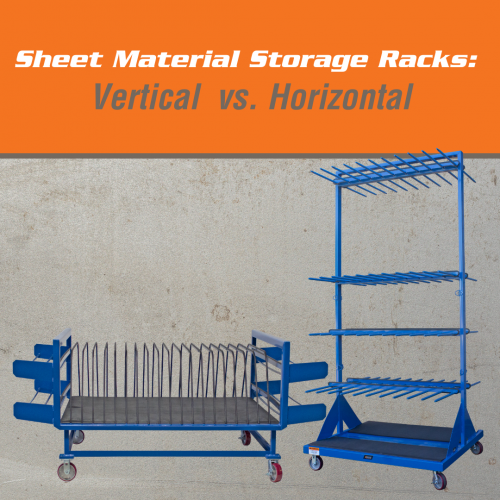We use cookies to make your experience better. To comply with the new e-Privacy directive, we need to ask for your consent to set the cookies. Learn more.
Sheet Material Storage Racks: Vertical vs. Horizontal

One solution is to find the ideal balance between storage footprint and easy access, whether you’re filling orders or feeding manufacturing lines. In other words, you need sheet metal racks that optimize throughput and use space efficiently. Broadly speaking, there are two types of sheet metal racks: vertical and horizontal. The former stores sheets standing on end; the latter stores them lying parallel to the ground. To decide which is best for your application, consider the following factors:
- How extensive is your inventory? Both vertical and horizontal sheet metal racks keep sizes, metal types, and gauges organized. But if you carry a full line of metals in a wide variety of gauges, you may benefit from roll-out shelving. These specialized horizontal sheet racks are easy to label and navigate at a glance, and they don’t necessarily rely on heavy equipment for access like some slide-out horizontal racks.
- What sort of material handling equipment is available? To carry loads of sheet metal on a forklift, many users rely on removable industrial shelves fitted with fork pockets. These sheet pallets require slide-out horizontal shelving. For smaller-scale applications, on the other hand, carts often provide more value than forklifts — and carts are often easier to load from vertical sheet metal racks like the BHS Sheet Material Rack.
- What are your access needs? The application always dictates the appropriate equipment, and sheet metal storage is no exception. If you’re warehousing bundles of sheet metal for bulk delivery, handling them with forklifts or an overhead crane, horizontal racks — or even cantilever racks — may be ideal. On a production floor, however, Sheet Material Racks provide more immediate manual access to individual sheets of metal. Manufacturers may need a combination of storage and mobility; in that case, the Mobile Sheet Material Rack from BHS is an ergonomic and efficient option for moving sheet materials. This heavy-duty cart stores materials safely between steel crossbars, preventing material damage from falling or bending during transit.
Ultimately, the choice between vertical and horizontal sheet metal storage will depend on the specifics of the application. Generally, though, here are the key differences between these two broad categories of sheet metal racks:
Vertical sheet metal racks typically offer a smaller footprint and provide easier manual access to materials. They’re the better solution for loading and unloading carts by hand. BHS offers customers two vertical storage rack options. The BHS Sheet Material Rack is stackable up to three units high to take full advantage of vertical space. Forklift pockets allow for convenient repositioning. The Sheet Material Rack keeps materials at safe, ergonomic heights, minimizing risky physical movements for workers.
Vertical Material Racks are great for long-term storage of materials, can be ordered with either one or two compartments, and come with durable casters for dependable mobility. Both vertical rack models minimize footprint and provide quick manual access, making them ideal for production applications.
Horizontal sheet metal storage racks are often more compatible with cranes, hoists, or forklifts. Horizontal racking systems do allow you to use sheet pallets, and they may provide for simpler organization. Because they store sheet metal lying down, however, horizontal racking requires quite a bit of floor space.
In short, vertical storage is ideal for sheet metal production applications, while horizontal is best for warehousing — generally speaking, of course. To discuss your unique material handling and storage needs, for sheet metal or anything else, contact the BHS sales team at 1.800.BHS.9500.
